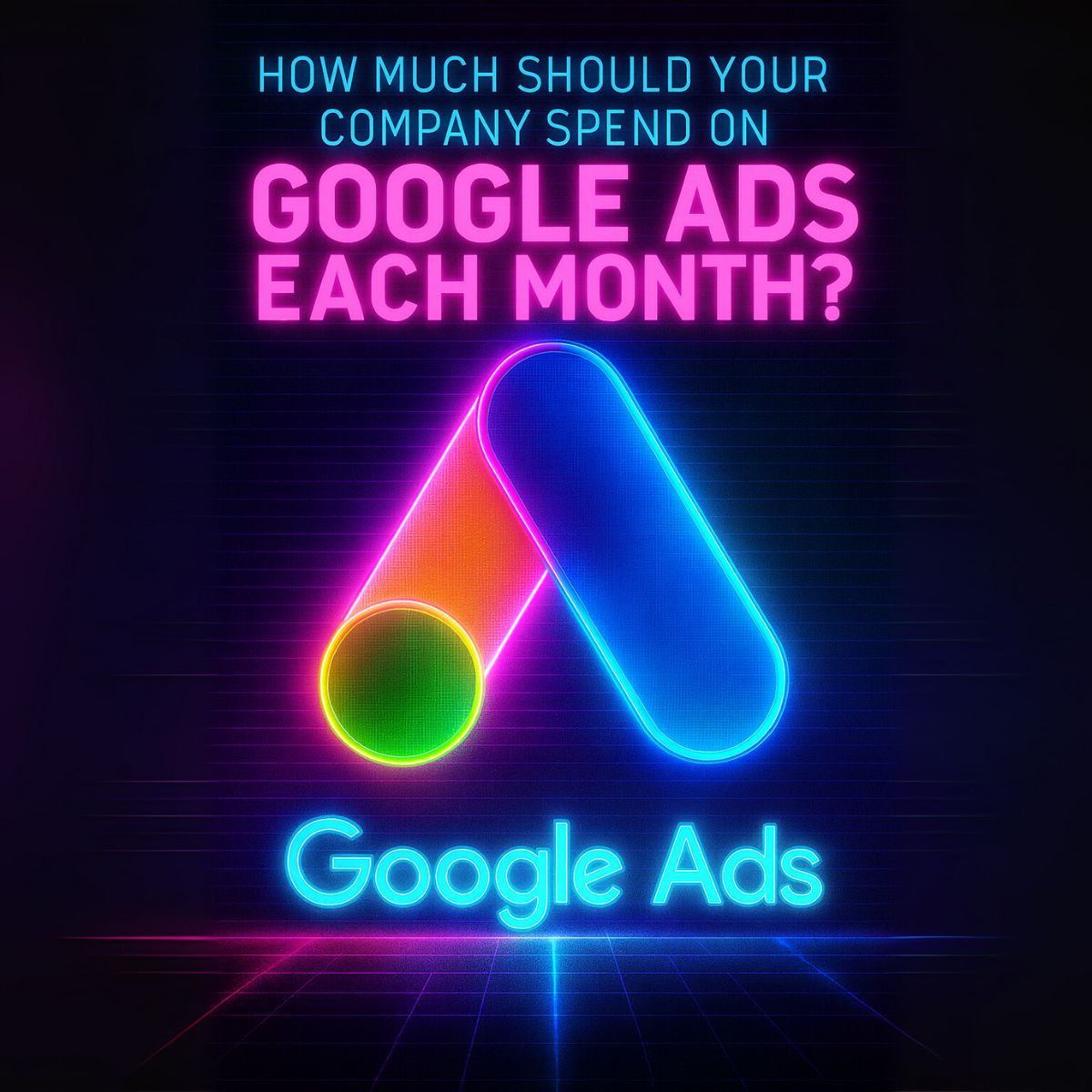Overview
Determining the right monthly budget for Google Ads is one of the most critical decisions facing businesses today. With digital advertising spending continuing to surge and competition intensifying across virtually every industry, the question “How much should we spend on Google Ads?” has become more complex than ever before.
The short answer is that there’s no one-size-fits-all solution. However, based on comprehensive industry research and expert analysis, most businesses should expect to invest between $1,000 and $10,000 per month on Google Ads, with the optimal amount depending on factors such as industry competition, business size, goals, and growth stage.
This comprehensive guide will walk you through everything you need to know about setting an effective Google Ads budget in 2025, from understanding current market benchmarks to calculating the right investment for your specific business situation.
The Current Google Ads Landscape in 2025
The digital advertising ecosystem has evolved dramatically, and understanding the current market conditions is essential for making informed budget decisions. According to the latest industry data from WordStream, the average cost per click (CPC) across all industries has reached $5.26 in 2025, representing a significant increase from previous years. This upward trend reflects the growing competition as more businesses recognize the value of paid search advertising.
The average cost per lead has similarly increased to $70.11, though this metric varies substantially across different industries and campaign types. What’s particularly encouraging for businesses considering Google Ads investment is that the platform continues to deliver strong returns, with Google reporting an average ROI of 800%, meaning businesses typically see $8 in revenue for every $1 spent on advertising.
These benchmarks provide a foundation for understanding the current market, but they represent averages across all industries and business types. The reality is that your actual costs and returns will depend heavily on your specific circumstances, competitive landscape, and how effectively you manage your campaigns.
For small and medium-sized businesses, the typical starting budget ranges from $1,000 to $2,500 per month, while most established businesses invest between $1,000 and $10,000 monthly. New campaigns often begin with daily budgets of $20 to $50, which translates to approximately $600 to $1,500 per month. These figures serve as useful starting points, but the optimal budget for your business requires a more nuanced analysis of your specific situation and objectives.
Industry-Specific Budget Considerations
One of the most significant factors influencing your Google Ads budget is your industry. The competitive landscape varies dramatically across different sectors, with some industries commanding premium prices for clicks while others offer more affordable entry points.
High-Competition Industries
Professional services represent some of the most competitive and expensive sectors in Google Ads. Legal services lead the pack with an average cost per click of $9.21, followed closely by business services at $8.50 per click. This premium pricing reflects the high lifetime value of clients in these industries, where a single new client can generate thousands or even tens of thousands of dollars in revenue.
Dental services ($6.69 per click), home improvement ($6.55 per click), and industrial/commercial services ($5.78 per click) also command higher prices due to their competitive nature and strong profit margins. For businesses in these sectors, monthly budgets often need to be substantial to achieve meaningful visibility and lead generation.
The high costs in these industries are justified by the economics of the business model. As one industry expert noted, “One new client could yield upwards of $1,000 to $10,000 depending on your business, so a CPC of $10 is a small price to pay for that client.” This perspective helps explain why businesses in professional services are willing to invest heavily in Google Ads despite the high per-click costs.
Moderate-Competition Industries
Mid-range industries include finance and insurance ($3.44 per click), health and fitness ($3.00 per click), and automotive services ($2.46 per click). These sectors offer a balance between competition and affordability, making them accessible to businesses with moderate advertising budgets while still providing opportunities for strong returns on investment.
Beauty and personal care ($2.32 per click), education and instruction ($2.27 per click), and career and employment services ($2.04 per click) fall into this category as well. Businesses in these industries can often achieve effective results with monthly budgets in the $2,000 to $8,000 range, depending on their geographic scope and competitive positioning.
Lower-Cost Industries
At the more affordable end of the spectrum, industries like arts and entertainment ($1.55 per click), apparel and fashion ($1.45 per click), and restaurants and food ($1.05 per click) offer lower barriers to entry. Travel advertising represents one of the most cost-effective options at just $0.44 per click.
However, businesses in these lower-cost industries face a different challenge. While individual clicks are less expensive, they typically need to reach significantly more customers to achieve the same revenue levels as higher-value service businesses. This means that while the per-click costs are lower, the total volume requirements may still result in substantial monthly budgets for businesses seeking meaningful growth.
Budget Recommendations by Business Size
Understanding how your business size and revenue should influence your Google Ads budget is crucial for making realistic and effective investment decisions. Industry experts recommend following a structured approach based on your company’s annual revenue and growth stage.
The Revenue-Based Budget Formula
The most widely accepted framework for determining digital advertising budgets follows a two-step calculation. First, businesses should allocate 6-10% of their total annual revenue to marketing activities. Then, within that marketing budget, 20-40% should be dedicated to digital advertising, including Google Ads.
This formula provides a sustainable approach that scales with business growth while ensuring that advertising investments remain proportional to overall business capacity. The specific percentages within these ranges depend on factors such as industry competition, growth goals, and the effectiveness of other marketing channels.
Small Business Budget Guidelines ($500K Annual Revenue)
For small businesses generating approximately $500,000 in annual revenue, the recommended marketing budget ranges from $30,000 to $50,000 per year. Within this allocation, Google Ads should receive $6,000 to $20,000 annually, translating to monthly budgets of $500 to $1,667.
However, many small businesses find that starting at the lower end of this range and scaling up based on performance provides the most sustainable approach. Torro Media recommends that small businesses begin with monthly budgets between $1,000 and $10,000, with beginners starting closer to $1,000 to $5,000 per month.
The key for small businesses is to start conservatively while ensuring sufficient budget to gather meaningful data. As one expert noted, “A good rule of thumb is to budget for at least 10 clicks per day, per campaign. This provides the bare minimum data the system needs to start optimizing.” This typically requires a minimum daily budget of $20-50, depending on your industry’s average cost per click.
Mid-Sized Business Recommendations ($5M Annual Revenue)
Mid-sized businesses with approximately $5 million in annual revenue should allocate $300,000 to $500,000 for marketing activities, with $60,000 to $200,000 dedicated to Google Ads annually. This translates to monthly Google Ads budgets ranging from $5,000 to $16,667.
At this level, businesses have more flexibility to test different campaign types, target broader audiences, and invest in competitive keywords. The increased budget allows for more sophisticated campaign structures, including separate campaigns for different product lines, geographic regions, or customer segments.
Mid-sized businesses also benefit from having sufficient budget to weather the initial learning period that Google’s algorithms require. With monthly budgets in the $7,000 to $30,000 range, these businesses can maintain consistent visibility while the platform optimizes campaign performance.
Enterprise Business Budgets ($50M+ Annual Revenue)
Enterprise businesses generating $50 million or more annually typically invest $3-5 million in marketing, with Google Ads receiving $600,000 to $2 million per year. This translates to monthly budgets ranging from $50,000 to $166,667, though many enterprise companies invest even more heavily in digital advertising.
At the enterprise level, Google Ads budgets often exceed $20,000 to $50,000 per month, allowing for comprehensive campaign coverage across multiple markets, products, and customer segments. These substantial budgets enable enterprise businesses to dominate competitive keywords, test advanced campaign strategies, and maintain consistent market presence across all relevant search terms.
Key Factors That Influence Your Google Ads Budget
Beyond industry and business size, several critical factors should shape your Google Ads budget decisions. Understanding these variables will help you make more informed investments and set realistic expectations for your campaigns.
Business Goals and Campaign Objectives
Your specific business objectives significantly impact the budget requirements for effective Google Ads campaigns. Different goals require different approaches and investment levels.
Lead Generation Campaigns typically focus on cost per lead (CPL) metrics and require sufficient budget to generate a meaningful volume of qualified inquiries. If your target is 50 leads per month and your estimated cost per lead is $20, your minimum monthly budget should be $1,000. However, this calculation assumes perfect efficiency, so most businesses should budget 20-30% above this baseline to account for optimization periods and market fluctuations.
E-commerce and Direct Sales campaigns prioritize return on ad spend (ROAS) and often require larger budgets to achieve meaningful sales volumes. A common target is a 3:1 ROAS, meaning you should allocate approximately one-third of your desired revenue increase to advertising spend. For example, if you want to generate an additional $30,000 in monthly revenue, plan for a $10,000 monthly Google Ads budget.
Brand Awareness Campaigns typically require the largest budgets because they focus on impressions and reach rather than immediate conversions. These campaigns often need 2-3 times the budget of conversion-focused campaigns to achieve meaningful market penetration and brand recognition.
Customer Lifecycle and Sales Complexity
The complexity of your sales process directly impacts your Google Ads budget requirements. Businesses with longer sales cycles need larger budgets to maintain visibility throughout the customer journey.
For high-ticket offerings or complex B2B sales, potential customers often require multiple touchpoints before making a purchase decision. This might involve several website visits, content downloads, webinar participation, and direct sales interactions before converting. During this extended process, your business needs to maintain consistent visibility and engagement, which requires sustained advertising investment.
Simple, low-consideration purchases typically convert more quickly and efficiently, allowing for lower budgets relative to revenue goals. However, complex sales processes require patience and sustained investment to nurture prospects through the entire decision-making journey.
Competitive Landscape and Market Position
Your competitive environment significantly influences the budget required to achieve meaningful results. In highly competitive markets, businesses need larger budgets to compete effectively for visibility and market share.
Tools like SpyFu and SEMrush can provide insights into competitors’ estimated ad spend and keyword strategies, helping you understand the competitive investment levels in your market. If competitors are investing heavily in Google Ads, you’ll likely need substantial budgets to compete effectively for the same audience.
Market position also matters. Established brands with strong recognition often achieve better Quality Scores and lower costs per click, allowing them to compete more efficiently. Newer businesses or those with less brand recognition may need larger budgets to achieve similar visibility and results.
Geographic Scope and Audience Size
The size and specificity of your target audience directly impact budget requirements. Local businesses targeting small geographic areas typically need smaller budgets than companies pursuing national or international markets.
However, highly specific audience targeting can sometimes increase costs due to limited inventory and increased competition for niche segments. The key is finding the right balance between audience size and targeting precision to achieve your goals within your budget constraints.
Starting with smaller geographic areas allows businesses to optimize their campaigns and prove effectiveness before expanding to larger markets. This approach helps maximize learning while minimizing risk and budget requirements during the initial campaign phases.
How to Calculate Your Optimal Google Ads Budget
Determining the right Google Ads budget requires a systematic approach that considers your business goals, market conditions, and financial constraints. Here are proven methods for calculating an effective budget that aligns with your objectives.
The Goal-Based Calculation Method
The most straightforward approach starts with your business objectives and works backward to determine the required investment. This method uses the formula: Monthly Budget = Target Conversions × Cost Per Conversion.
For example, if you need 50 new leads per month and research indicates your industry’s average cost per lead is $40, your baseline budget should be $2,000 monthly. However, this calculation assumes perfect efficiency from day one, which rarely occurs in practice.
To account for the learning period and optimization process, add a 25-50% buffer to your calculated budget. Using the example above, plan for $2,500 to $3,000 monthly to achieve your 50-lead goal reliably. This additional investment provides room for testing, optimization, and market fluctuations while ensuring you can maintain consistent performance.
The Revenue Percentage Method
The revenue percentage approach provides a sustainable framework that scales with business growth. Start by determining your total annual revenue, then apply the industry-standard allocation percentages.
Calculate 6-10% of your annual revenue for total marketing spend, then allocate 20-40% of that marketing budget to Google Ads. For a business generating $2 million annually, this translates to:
- Total marketing budget: $120,000 – $200,000
- Google Ads allocation: $24,000 – $80,000 annually
- Monthly Google Ads budget: $2,000 – $6,667
This method ensures your advertising investment remains proportional to your business capacity while providing flexibility to adjust based on performance and market opportunities.
The Competitive Analysis Approach
Understanding your competitive landscape helps establish realistic budget expectations and identify opportunities for market positioning. Research your competitors’ estimated advertising spend using tools like Google’s Keyword Planner, which provides cost estimates for relevant keywords in your industry.
Analyze the top 5-10 competitors in your market to understand the investment levels required for competitive visibility. If leading competitors are investing $10,000-15,000 monthly, you’ll likely need similar budgets to compete effectively for the same audience and keywords.
However, don’t assume you need to match the highest spenders immediately. Focus on identifying gaps in competitor coverage or opportunities to compete more efficiently through better targeting, ad quality, or landing page optimization.
The Incremental Testing Strategy
For businesses new to Google Ads or those with limited budgets, the incremental testing approach provides a low-risk method for determining optimal investment levels. Start with a conservative budget that allows for meaningful data collection, then scale based on performance.
Begin with 10-20% of your calculated optimal budget to test campaign effectiveness and gather performance data. If initial results demonstrate positive ROI, gradually increase investment by 25-50% monthly until you reach your target budget or hit diminishing returns.
This approach typically starts with $500-1,500 monthly budgets for small businesses, allowing for campaign testing and optimization without significant financial risk. As performance data validates the effectiveness of your campaigns, you can confidently increase investment to capture more opportunities.
Budget Allocation Across Campaign Types
Once you’ve determined your total Google Ads budget, strategic allocation across different campaign types maximizes effectiveness and coverage. A balanced approach typically includes:
Search Campaigns (60-70% of budget): Focus on high-intent keywords where users are actively searching for your products or services. These campaigns typically deliver the highest conversion rates and most immediate ROI.
Display and Video Campaigns (15-25% of budget): Build brand awareness and reach users earlier in the buying journey. These campaigns often have lower immediate conversion rates but contribute to overall brand recognition and long-term customer acquisition.
Experimentation and Testing (10-20% of budget): Reserve budget for testing new keywords, ad formats, audiences, and campaign strategies. This investment in innovation helps identify new opportunities and prevents campaign stagnation.
This allocation framework provides a starting point, but optimal distribution varies based on your industry, goals, and competitive landscape. Regular performance analysis should guide adjustments to maximize overall campaign effectiveness.
Common Budget Mistakes and How to Avoid Them
Understanding common budgeting pitfalls helps businesses maximize their Google Ads investment and avoid costly mistakes that can undermine campaign effectiveness.
Setting Budgets Too Low for Meaningful Data
One of the most frequent mistakes is setting budgets too low to generate sufficient data for optimization. Google’s algorithms require adequate volume to identify patterns and optimize performance effectively. Campaigns with insufficient budget often struggle to exit the learning phase and achieve stable performance.
The minimum effective budget varies by industry, but most campaigns need at least 10-15 clicks per day to provide meaningful optimization data. In competitive industries with high cost-per-click rates, this might require daily budgets of $100-200 or more. Businesses that set daily budgets of $10-20 in high-competition markets often see poor performance simply due to insufficient data volume.
To avoid this mistake, calculate the minimum budget required for your industry’s average CPC and ensure your daily budget can generate at least 10-15 clicks. If this minimum budget exceeds your comfort level, consider focusing on less competitive, long-tail keywords or smaller geographic areas to reduce costs while maintaining adequate data volume.
Expecting Immediate Results Without Patience
Google Ads campaigns typically require 2-4 weeks to stabilize and show reliable performance patterns. Many businesses make budget decisions based on first-week performance, which often leads to premature campaign cancellation or misguided optimization efforts.
The platform’s machine learning algorithms need time to understand your audience, optimize bidding strategies, and identify the most effective ad placements. During this learning period, performance may fluctuate significantly, and costs per conversion might be higher than long-term averages.
Plan for this learning period by committing to at least 30 days of consistent budget allocation before making major campaign adjustments. This patience allows the algorithms to optimize effectively and provides more reliable data for future budget decisions.
Failing to Account for Seasonal Variations
Many businesses set static budgets without considering seasonal demand fluctuations that significantly impact Google Ads performance. Industries like retail, travel, and professional services often experience dramatic seasonal variations in search volume and competition levels.
During peak seasons, increased competition drives up costs per click, requiring larger budgets to maintain visibility and market share. Conversely, off-peak periods might offer opportunities to capture market share at lower costs with reduced budgets.
Develop seasonal budget strategies that align with your industry’s demand patterns. Increase budgets during high-demand periods to capitalize on increased search volume, and consider reducing budgets during slower periods while maintaining consistent brand presence.
Ignoring the Relationship Between Budget and Quality Score
Google’s Quality Score significantly impacts your cost per click and ad positioning, but many businesses overlook how budget allocation affects Quality Score optimization. Campaigns with insufficient budgets often can’t compete for premium ad positions, leading to lower click-through rates and reduced Quality Scores.
Lower Quality Scores create a negative cycle where poor performance leads to higher costs, which further reduces campaign effectiveness within the same budget. Conversely, adequate budgets allow campaigns to compete for better positions, potentially improving Quality Scores and reducing long-term costs.
Invest in Quality Score optimization by ensuring sufficient budget for competitive positioning, creating high-quality ad copy and landing pages, and maintaining relevant keyword targeting. These investments often reduce long-term costs while improving overall campaign performance.
Optimization Strategies for Maximum Budget Efficiency
Effective budget management extends beyond initial allocation to ongoing optimization strategies that maximize return on investment.
Implementing Smart Bidding Strategies
Google’s automated bidding strategies can significantly improve budget efficiency by optimizing bids in real-time based on conversion likelihood. Target CPA (Cost Per Acquisition) and Target ROAS (Return on Ad Spend) bidding strategies automatically adjust bids to achieve your specified goals within your budget constraints.
These automated strategies typically outperform manual bidding for businesses with sufficient conversion data, usually requiring at least 30 conversions in the past 30 days for optimal performance. For newer campaigns or those with limited conversion data, start with manual bidding or enhanced CPC until you accumulate sufficient data for automated strategies.
Geographic and Demographic Optimization
Regular analysis of performance by geographic location and demographic segments often reveals opportunities for budget reallocation. Some locations or audience segments may deliver significantly better ROI than others, suggesting opportunities to shift budget toward higher-performing segments.
Use Google Ads’ geographic and demographic reports to identify top-performing areas and audiences. Consider increasing budgets for high-performing segments while reducing investment in underperforming areas. This optimization can significantly improve overall campaign efficiency without increasing total budget.
Time-of-Day and Day-of-Week Adjustments
Performance often varies significantly by time of day and day of week, presenting opportunities for budget optimization through bid adjustments and scheduling. Analyze your conversion data to identify peak performance periods and adjust budgets accordingly.
Increase bids during high-converting time periods and reduce or pause campaigns during low-performance windows. This strategy concentrates your budget during periods when your audience is most likely to convert, improving overall efficiency and ROI.
Conclusion: Making Smart Google Ads Budget Decisions in 2025
Determining the optimal
budget for your business requires careful consideration of multiple factors, from industry competition and business size to specific goals and competitive positioning. While the average business invests between $1,000 and $10,000 monthly, your optimal budget depends on your unique circumstances and objectives.
The key to successful Google Ads budgeting lies in starting with a data-driven approach that considers your revenue capacity, industry benchmarks, and competitive landscape. Use the revenue percentage method as a foundation, allocating 6-10% of annual revenue to marketing and 20-40% of that to digital advertising. This framework ensures sustainable investment levels that scale with business growth.
Remember that Contact Brain Buzz Marketing today to ensure your Google Ads budgeting is on point! is not a set-it-and-forget-it decision.
Successful campaigns require ongoing optimization, seasonal adjustments, and strategic reallocation based on performance data. Start conservatively if you’re new to the platform, but ensure sufficient budget for meaningful data collection and optimization.
The substantial ROI potential of Google Ads—with an average return of $8 for every $1 invested—makes it a compelling investment for businesses across industries. However, realizing this potential requires strategic budget allocation, patient optimization, and commitment to best practices.
Whether you’re a small business starting with a $1,000 monthly budget or an enterprise company investing $50,000+ per month, the principles remain the same: align your budget with your goals, understand your competitive landscape, and continuously optimize based on performance data. With the right approach, Google Ads can become one of your most effective channels for sustainable business growth.
As you develop your Google Ads budget strategy, remember that the most expensive mistake is not investing enough to generate meaningful results. It’s better to start with a focused, adequately funded campaign in a limited market than to spread an insufficient budget across too many opportunities. Focus, measure, optimize, and scale—this approach will help you build a successful Google Ads program that delivers consistent returns on your investment.
Maximize your ROI with Brain Buzz Marketing’s expert guidance on Google Ads budgeting. Contact us today to get started!









